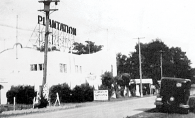
As long as Minnesotans have known notoriously brutal Midwest winters, we have celebrated the reprieve summer weather brings and enjoyed relaxing on the beach. From the state’s infancy, White Bear Lake has served as one of these vacation getaways.
White Bear Lake Township officially formed in 1858 as Minnesota became a state, with the township including what today is Gem Lake, North Oaks and Vadnais Heights. By 1868-1870, the population of the resort town routinely swelled in warmer months, drawing in regular visitors brought in by the newly built railroad.
Connecting from the booming city of St. Paul to the south and continuing up north to Lake Superior at Duluth, the railway made vacationing in White Bear more accessible, says Sara Markoe Hanson, White Bear Lake Area Historical Society’s executive director. The railway offered ease and flexibility to urban dwellers eager to escape the heat and hustle of city life for the relaxation the lake provided.
“That was the key. When the railroad hit White Bear, things just took off. People could get here much more easily,” Hanson says. “It was a three-hour trip from St. Paul before—people did it, but it wasn’t as simple.”
With its strong tourism infrastructure, White Bear became home to a number of mansion-like hotels and their cottages, including the Williams House on Lake Avenue, the Leip House, Châteaugay and the Ramaley Pavillion.
Such venues even made it into the pages of Mark Twain, with the Missouri-born writer including White Bear Lake in his “Life on the Mississippi,” written in 1874, drawing more attention to the area as a vibrant resort destination.
Often going beyond simple room and board, the typical hotel would generally house a saloon or restaurant, entertainment and gathering spaces, along with leisure amenities, like boating, billiards, golf and bowling. Vacationers could opt for a room in the main hotel or rent a cottage for longer stays.
The accessibility of the rail system also meant a varied demographic of visitors. For those who perhaps could not afford hotel or rental fees all season long, camping near the water was also a popular option.
“A lot of folks in those early years would come and tent by the lake. Literally villages of tents and people would pop up in these campgrounds,” Hanson says, although, as she explains, what we typically think of as camping today is a far cry from the experience in the late 1800s—imagine 19th century “glam camping.”
“They camped very differently than today: ‘glamping.’ They would bring their beds, framed family portraits. They would commit! Roughing it, but not entirely,” Hanson says.
Vacationing style also differed from what we think of today. In 19th century polite society, social norms meant women dressed in seven layers of clothing—no matter the weather or activity. Men did not go out unless they were properly dressed either.
“If women were out in public in any way, they had to be covered. I can’t imagine,” Hanson says. “They did have swimsuits, they would go in the water, but it wasn’t nearly what we think of as going to the beach now.”
Unlike today’s long weekend getaways to cabins, vacationers would often stay at the lake for the whole summer season, typically May through September. Some homesteaded their own cottages, independent from the hotels.
The Fillebrown is one of the small number of these cottages still standing. Built near the water in 1879 by the Noyes family, the picturesque-style property sits at Lake and Morehead Avenues. In the 1920s, the original outdoor kitchen was moved closer and attached to the main house, Hanson says.
This structure, also known as the Red Chalet, continued as a summer retreat for nearly a century, served a variety of purposes, including being a year-round residence. Retaining its Victorian Stick style charm, in 1978 it was donated, along with its contents, to the Historical Society and is on the National Registry of Historic Places. Now in use for events and tours, it is one of the few buildings to survive this period with its aesthetics intact.
On the 4300 block of Cottage Park Road also sits a remnant of this era. This structure from the 1880s was designed by prominent architect Cass Gilbert and also keeps its design integrity, says Hanson. Another cottage on Pine St. in Mahtomedi is still in use as a residential vacation spot, with its structure and style remaining intact since the 1930s.
Lake Country Booksellers on Washington Avenue boasts its own building history. In its first life, this structure was an 1870s hotel and saloon located adjacent to the train depot—now the highway.
“Perfect example of cars taking over the railroad,” says Hanson.
The denouement of the resort era arrived with the availability of the automobile and phasing out trains as the go-to travel method.
“People stopped necessarily going where the trains went because they could go other places,” says Hanson
These are some of the few unknown structures left from this period in White Bear’s history. Hanson says there are likely some cottages still intact, but unrecognizable due to remodeling and redesign. Others, including virtually all of the noteworthy hotels of this time,have simply disappeared, she says.
“By 1910s, a lot of these hotels had burned. Very common, because of how they were heating their homes, lighting, cooking—a lot of them weren’t being rebuilt,” Hanson explains. “Beyond that, there’s just not a lot of evidence left.”
Hanson herself has her own tie to this historic period. Growing up in the area, her great-great grandparents were some of the earliest White Bear Lake vacationers, eventually building their own cottage in the 1860s or 1870s. The building still stands at the corner of Shady Lane and Lake Ave.
One of the Historical Society’s many events is a 1.5 mile-long walking tour through town, highlighting the preserved buildings, providing insights into White Bear Lake’s early years. The tours touch on about 10 specific locations.
“It’s fun--there are things people don’t really notice. They go about their day, and don’t always look around and realize what’s there,” Hanson says. She notes that it’s important that certain buildings are recognized as significant, and is happy that they’re being taken care of.
For those hosting a group, the society also offers events, tours and other historic activities specialized and scheduled depending on interest.









